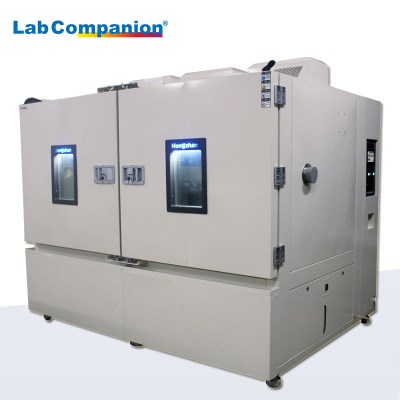Envoyez-nous un email :
info@lab-companion.com labcompanionltd@gmail.com-

-

Demander un appel :
+86 18688888286
Lorsque la chambre d'essai d'impact d'eau glacée de Guangdong Hongzhan est utilisée en été, les points suivants doivent faire l'objet d'une attention particulière pour garantir le fonctionnement stable de l'équipement et l'exactitude des résultats des tests :
1. Gestion de l'environnement et de la dissipation thermique
Améliorer la ventilation et la dissipation thermique. Les températures élevées en été peuvent facilement réduire l'efficacité de la dissipation thermique des équipements. Prévoir un espace d'au moins 10 cm autour de l'équipement pour favoriser la circulation de l'air. Si l'équipement est équipé d'un système de refroidissement par air, la poussière à la surface du condenseur doit être nettoyée régulièrement afin d'éviter une mauvaise dissipation thermique et une surchauffe du compresseur. Contrôler la température et l'humidité ambiantes. Éviter d'exposer l'équipement à la lumière directe du soleil. Il est recommandé de maintenir la température du laboratoire à 25 ± 5 °C et l'humidité inférieure à 85 %. Une température et une humidité élevées peuvent accélérer l'accumulation de givre ou de condensation sur l'équipement ; il est donc nécessaire de renforcer les mesures de déshumidification.
2. Entretien du système de réfrigération
Qualité de l'eau et gestion du réservoir : les bactéries se multiplient facilement en été. Utilisez donc de l'eau déionisée ou pure pour éviter l'entartrage et le blocage des canalisations. Il est recommandé de changer l'eau du réservoir tous les 3 jours, puis de le vider et de le nettoyer avant toute utilisation prolongée. Surveillance de l'efficacité de la réfrigération : les températures élevées peuvent entraîner une surcharge du système de réfrigération. L'état de l'huile du compresseur doit être vérifié régulièrement pour garantir une quantité suffisante de réfrigérant. Si la température de l'eau dépasse la valeur définie (par exemple, 0 à 4 °C), la machine doit être immédiatement arrêtée pour dépannage.
3. Traitement de glaçage et de décongélation
Prévenir l'aggravation du gel. En été, l'humidité est élevée et le taux de gel à l'intérieur de l'appareil peut s'accélérer. Il est recommandé d'effectuer un dégivrage manuel après 10 cycles : régler la température à 30 °C et la maintenir pendant 30 minutes, puis vidanger l'eau pour éliminer les cristaux de glace à la surface de l'évaporateur.
Optimisez l'intervalle de test afin d'éviter les tests prolongés à basse température. Il est recommandé de prévoir un temps tampon de 15 minutes entre les cycles de choc thermique à haute température (par exemple, 160 °C) et à l'eau glacée afin de réduire l'impact du stress thermique sur l'équipement.
4. Ajustement des spécifications de fonctionnement
Optimisation des paramètres Selon les caractéristiques de l'environnement estival, le temps normal de récupération de la température peut être raccourci de manière appropriée (la norme de référence est de terminer la commutation de température en 20 secondes), mais il doit s'assurer qu'il répond aux exigences des normes GB/T 2423.1 ou ISO16750-4. La protection de sécurité doit être renforcée. Des gants et des lunettes antigel doivent être portés pendant le fonctionnement pour éviter l'adhérence des mains aux pièces à basse température causée par la transpiration. Avant d'ouvrir la porte après un test à haute température, la température à l'intérieur de la boîte doit être confirmée comme étant inférieure à 50 °C pour éviter les brûlures par la vapeur chaude.
5. Préparation aux arrêts d'urgence et à long terme
Réponse aux pannes Si l'appareil affiche l'alarme E01 (température hors tolérance) ou E02 (niveau d'eau anormal), coupez immédiatement l'alimentation électrique et contactez le support technique du fabricant. Ne démontez pas la tuyauterie de réfrigération vous-même. Protection à long terme : en cas de non-utilisation pendant plus de 7 jours, videz le réservoir d'eau, coupez l'alimentation et recouvrez le couvercle anti-poussière. Maintenez l'appareil sous tension pendant 1 heure tous les quinze jours afin de maintenir le circuit imprimé sec.

Grâce aux mesures ci-dessus, l'impact des températures et de l'humidité élevées en été sur la chambre d'essai de choc glacial peut être efficacement réduit, garantissant ainsi la fiabilité des données d'essai et la durée de vie de l'équipement. Les détails de fonctionnement spécifiques doivent être ajustés en fonction du manuel de l'équipement et des conditions de travail réelles.